Wellington has long had a good sense of social justice in its housing portfolio – but has also been lagging behind with the upgrades, until recently. Over the last 10 years many of the social housing blocks in Wellington have been substantially refurbed – and now comes the turn of Arlington. This block, a large central city Mt Cook / Te Aro / Edge of Aro Valley / bottom of Brooklyn, has been the big question mark for years. It was built in 3 stages, and some of the buildings were great – others maybe not so good. It is certainly getting tired round the edges – and apparently damp inside. So, after a few years of secret squirrel design, a major new rebuild has been announced, with a Consortium of people/practices involved:
“The consortium includes Hawkins Construction, Novak+Middleton, Dunning Thornton, Boffa Miskell, Stephenson and Turner, Beca, Motm, Holmes Fire, Acousafe and Stantiall Studio.”
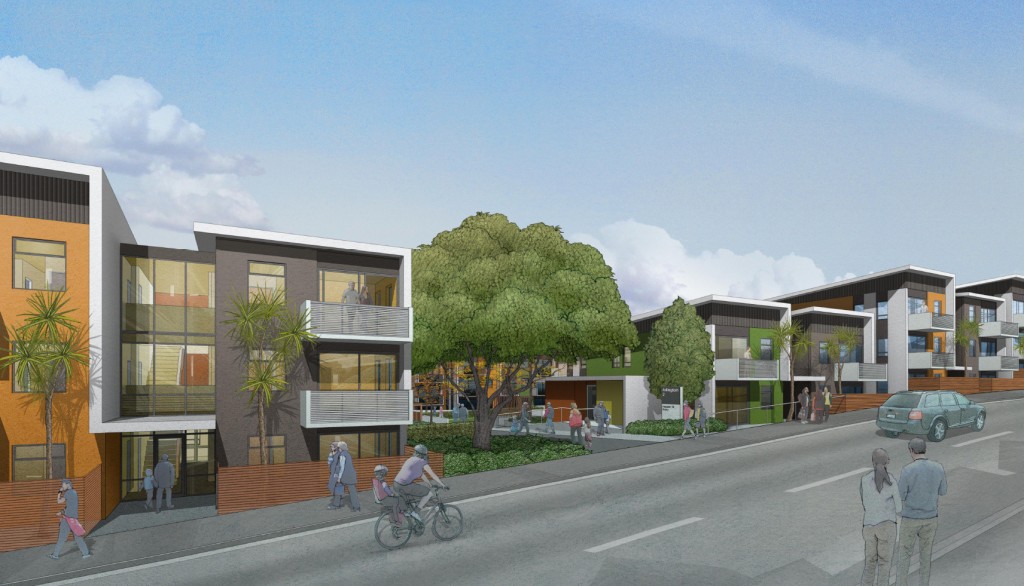
(all images courtesy of the Hawkins team, and all credit to the architects, engineers, contractors and of course Stantiall Studio).
Info from the official press release follows:
An application for resource consent for the $33 million development, on a large city block bounded by Taranaki, Hopper and Hankey streets, is expected to be lodged before the end of this year. If the application is successful, the existing 1970s Council housing will be demolished. Site preparation work on the new project could start March 2016.
Wellington Mayor Celia Wade-Brown says the consortium’s design is attractive, sustainable and an excellent use of the very conveniently located site. “The Arlington redevelopment will be a long-standing symbol of our Council’s commitment to the right of everyone to have secure, safe, warm and affordable housing. Any city that promotes itself as genuinely diverse and liveable must provide affordable high-quality social housing.â€
Councillor Paul Eagle, Chair of the Council committee responsible for social housing, says the development will usher in a new era of flexible rental housing for those Wellingtonians most in need.
“Our tenants often cannot afford private market rents, or face discrimination in the market.â€
An application for resource consent for the $33 million development, on the corner of Taranaki, Hopper and Hankey streets, is expected to be lodged before the end of this year. If the application is successful, the existing 1970s Council housing will be demolished. Site preparation work on the new project could start March 2016.
Main features of the proposed development:
· Delivers affordable, sustainable, flexible accommodation that is modern, warm, safe and secure.
· The 105 new apartments will provide space for 324 residents – almost double the 166 residents as of now.
· The apartments have been designed as ‘modular’ residences. With minimal alterations, they can be reconfigured from single-bed apartments to multi-bedroom units that can accommodate large families, and vice-versa.
· A large central communal landscaped park will be a defining feature of the site. The central landscaped space will promote a sense of belonging and community for the tenants.
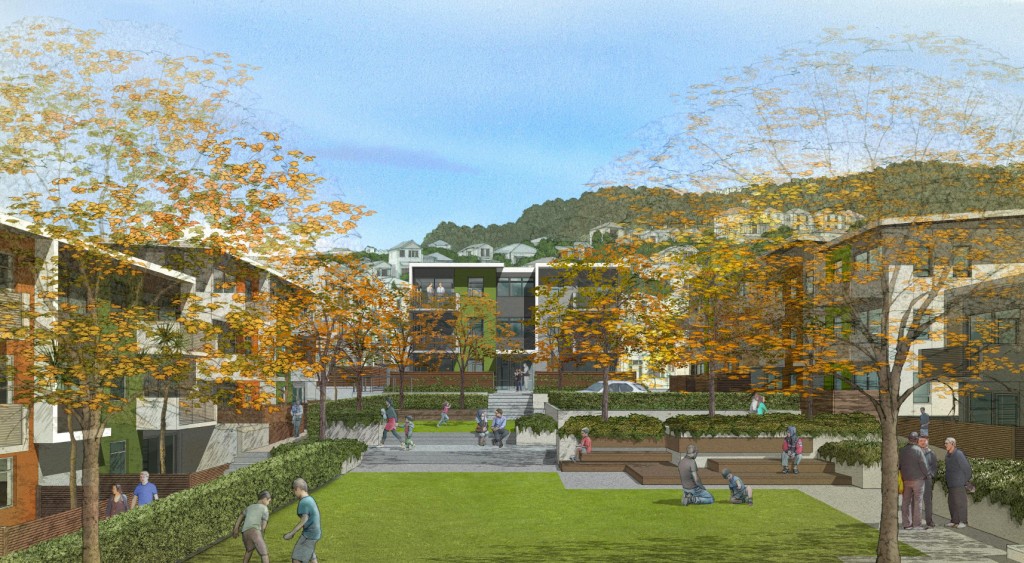
The project is the latest stage in the City Council’s Housing Upgrade Programme – a $400 million programme jointly funded with the Crown. The programme to upgrade the Council’s social housing – most of it dating from the 1960s and 1970s – has been under way since 2008. The proposed Arlington project will be the third entirely ‘new-build’ project of the upgrade programme. The majority of the projects have involved quake-strengthening existing buildings and then comprehensively updating the accommodation to improve heating and ventilation, insulation, kitchens and bathrooms and security, as well as indoor and outdoor community facilities. Hawkins Project Director Matt Wilton says: “We are tremendously excited to be given the go-ahead to investigate the proposal further with the City Housing team. “This project, if it gets final approval, will transform this area – it will be an exemplar for future modern residential developments nationally.â€
Novak+Middleton Director Simon Novak says: “We’ve responded to the design brief as much as possible with modular designs that are light and airy but also warm and highly flexible.†Mr Novak says the modular design of Arlington Apartments is a New Zealand first in adaptability and flexibility in multi- unit housing. All apartments can be easily reconfigured from the standard one-bedroom apartment module, to a range of unit types, from bedsits up to seven bedroom family units, all with minimal modification.â€
The Council’s City Housing Manager, Vicki McLaren, says the proposed development is a great example of what can be done when the client, contractor and designers all share the same vision, and are leaders in their respective fields. “The City Council’s design-build procurement strategy enabled participating teams to choose their own participants and collaborate from the project onset. The successful team had a common goal to design and construct affordable, innovative and adaptable modular housing that would provide residents with quality housing and bring new energy to the city.â€
Key design points for Arlington Site 2:
• Social housing that residents can be proud to call home
• Warm, dry, safe and healthy housing that is suitable for modern living
• A New Zealand first in adaptability and modularity in multi-unit housing
• Excellent environmental performance
• Designed to integrate into and enhance the local urban environment
• Small communities of residents sharing buildings, where they can know their immediate neighbours
• Ground floor apartments with flow to green space
• A large, sunny and sheltered landscaped courtyard bordered by three-storey multi-unit buildings with glass stairwells
• Community facilities for social and recreational use, linked to central green area
• The fundamental principles of Crime Prevention through Environmental Design (CPTED) underpin the design
• Robust, resilient, low cost to use and easy to maintain
• Modern design with multiple options for cladding and colour schemes
Post-script: updated with current Arlington flats included.
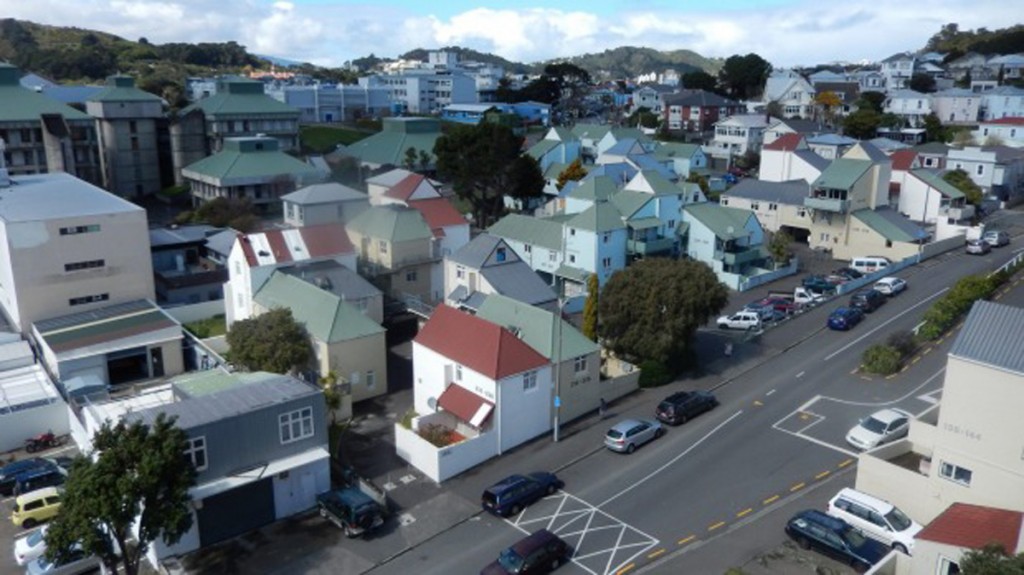
Arlington Tower, teh Athfield designed part, is of course also under threat of demolition due to seismic upgrade issues…
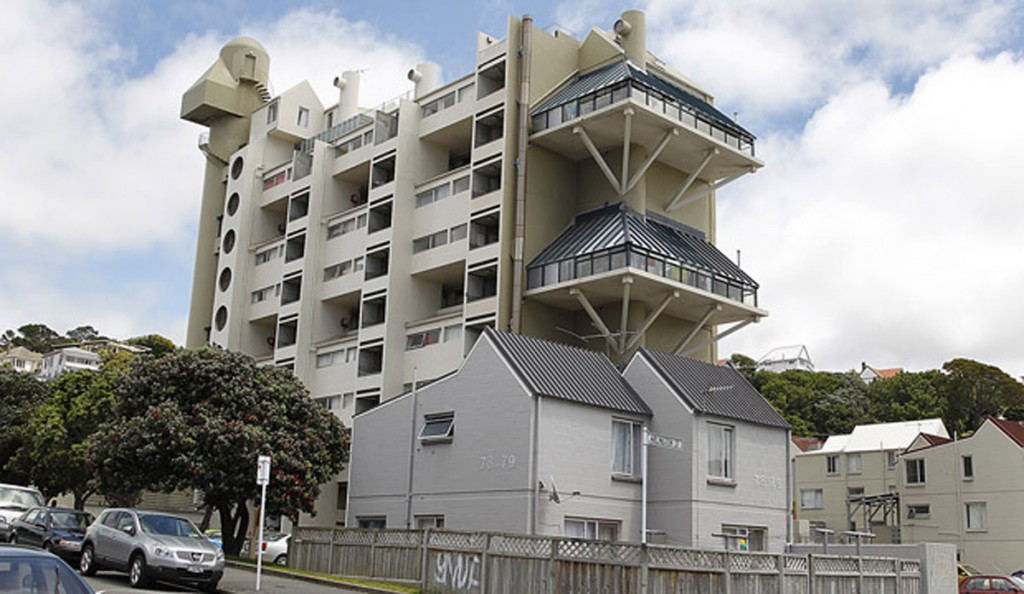

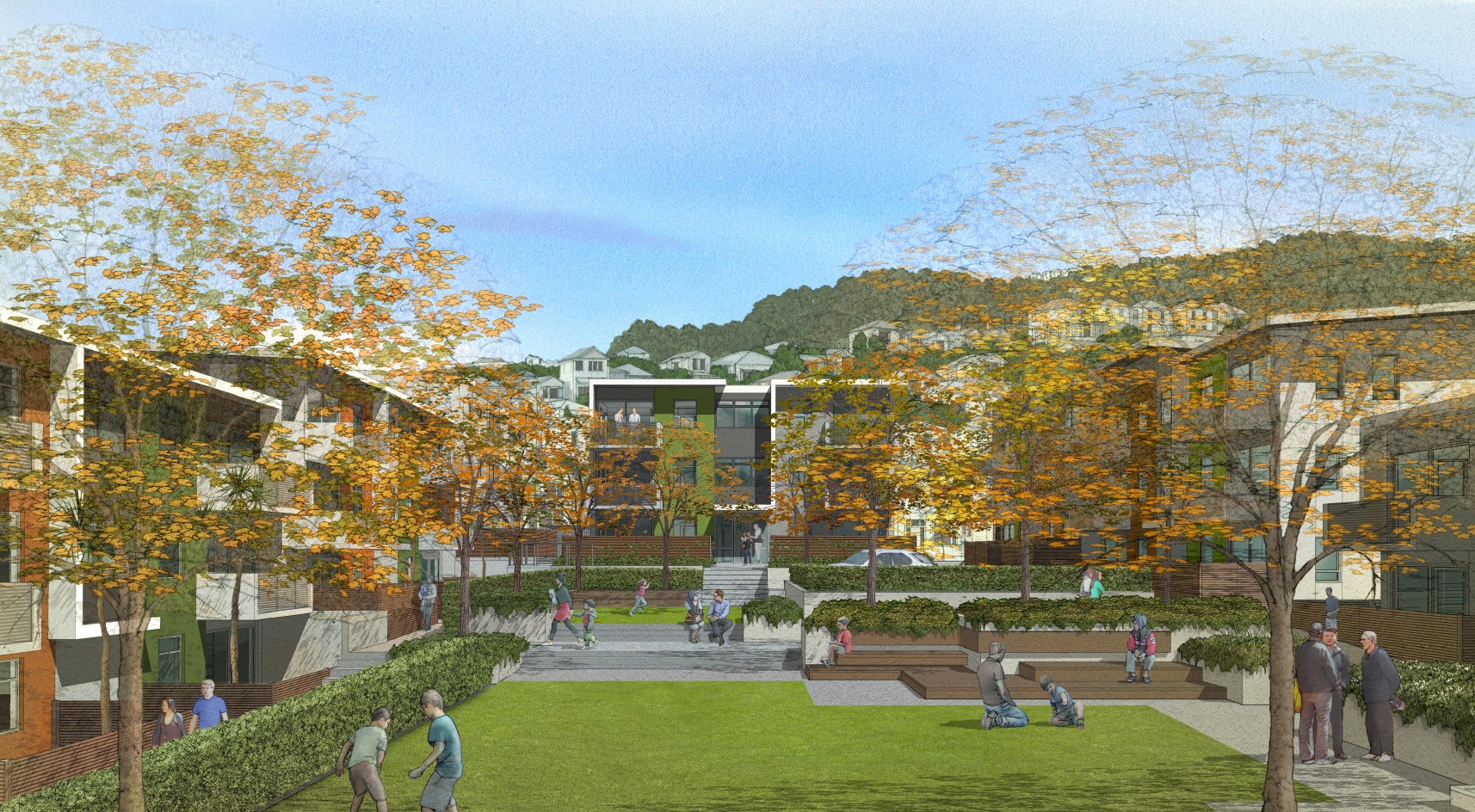
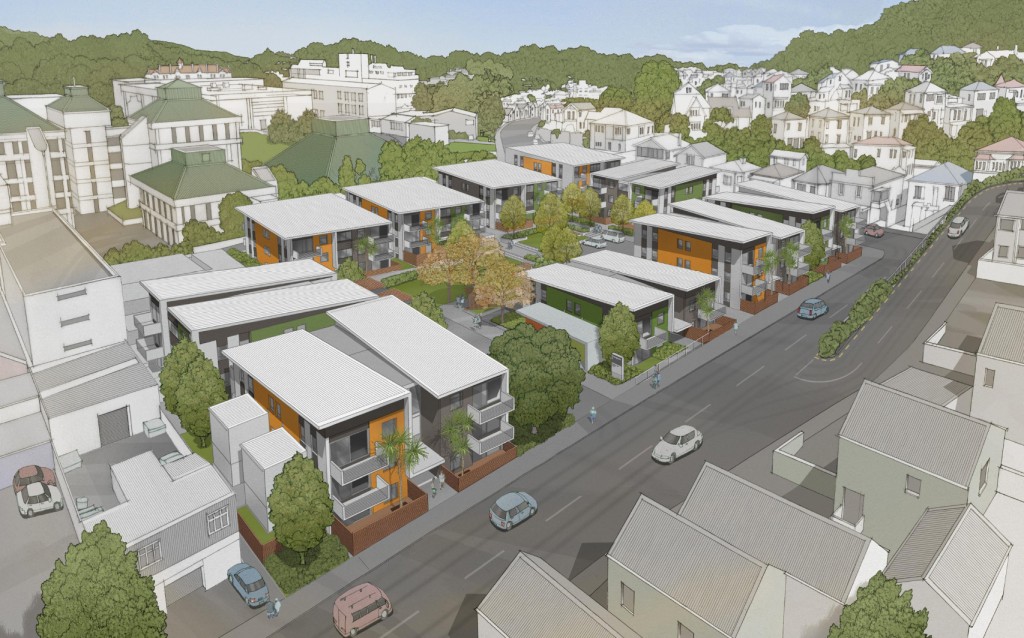



Has the Curse of Roger Walker now moved on to Athfield?
The Curse of Roger Walker ? I wasn’t aware that he was cursed, although am reasonably certain that at times he does, perchance, utter curses. Mostly involuntary chants like “More Pinot please vicar”.
I was referring to the Four Demolition Men of the Apocalypse who have taken out the Wellington Club, Perretts Corner, Centrepoint et al.
Aaah. Indeed! And the greek temple on the side of Mt Vic. Forgive me father Stark, but I have sinned – I’m not actually aware of which bits were designed by who. The tall building I know is Athfield Architects, but there is a whole lot of buildings on the ground floor – and I don’t know whose are whose. What was here (still is here, actually) sort of looks like Walkers, but also could be WCC architects copying the Ath/Walker style?
When I google Arlington to find out what, I keep getting rick-rolled into the Wellington apartments in Arlington, Virginia, which is a whole different kettle of fish.
This land is zoned outer residental and maximum height of outer residental is 8m. The council obviously has a different set of rules when it is their own development.
… and you’re back
“Novak+Middleton Director Simon Novak says: “We’ve responded to the design brief as much as possible with modular designs that are light and airy but also warm and highly flexible.—
And the Council as client, should make this design public domain and available to developers as an easy consentable option for city fringe intensification,
Council is spending a lot of public money (both its and central governments) to get these designs right, and is winning sifnificant kudos from the Architectural Fraternity (Drapes, phonelines and draughtly rangehoods withstanding) – It should share what it has created, and incentive this through with a more relaxed consent process as the design is well understood.
I understand that many of the original 1950s state house deisgns were copied by the private builders of the day, and that that using governmetn plans made it much easier to get a govenrment loan….
Surely the council would have nothing against more of these new designs being build by private developers…
We are indeed back – bit of a server crash there for a while, but the head honcho Philip has managed to apply the electrodes to the corpse, and get some more life out of the old thing yet. We may yet survive.
Green welly, thank you for your comment. Not sure I entirely understand you – you think the Council should put these designs in the public domain? But aren’t they the designs of Novak + Middleton? So not actually the property of the council, in terms of the plans? In any case, developers seem to love to do similar, but different things each time they build. Never really known any developer to build exactly the same thing time after time – sure, the volume house builders do, but everyone else keeps doing new variations on the same wheel.
@Levi,
My point was that they are claiming that these designs are “highly flexible” and thus would lend themselves to being used in many different situations,
We are continually told that building housing in NZ is exceedingly expensive, and it would seem that having some form of modular design that council is very familier with would be a one way to help lower the costs to both development and the time and effort to gain approval…
*whew* Glad to be getting my (m)eth(noichthyology) fix again.
Hope you told those pesky Russian spammers to отвÑжиÑÑŒ?
Sea monkey – your daily fish finger is back. Glad to hear at least someone is still reading!
Green Welly – ok, I see what you are getting at, and yes, I absolutely agree. But from my recent experience with getting a building priced, the exorbitant cost of building is not due to Council regs and compliance, but simply the cost of materials themselves. That’s where the real killer lies, believe me. Almost made me want to import my materials straight from China, as opposed to buying Kiwi made, but that offends my principles. But man, you pay through the nose for being patriotic. There has to be a better way.